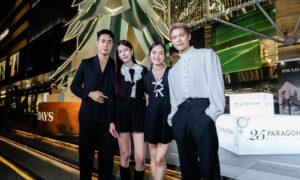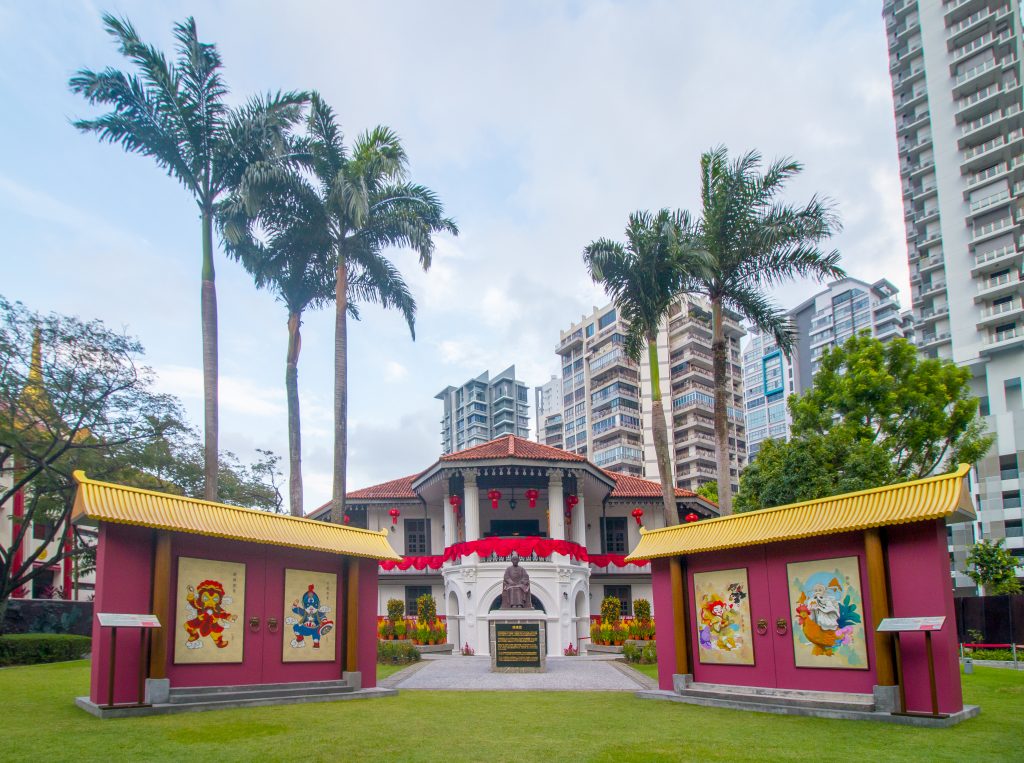
To herald this Lunar New Year season, Sun Yat Sen Nanyang Memorial Hall (SYSNMH) presents a special exhibition, Nian Hua: Of Deities, Guardians and Auspicious Art, which showcases the centuries-old Chinese tradition of Nian Hua and its significance.
Taking place from 21 January to 25 September 2022, it features close to 70 artefacts which originate from different provinces of China and is presented in collaboration with one of the largest museums in China, the Chongqing China Three Gorges Museum.
On January 21, 2022, Guest-of-Honour and Minister for Culture, Community and Youth and Second Minister for Law Mr Edwin Tong launched the exhibition at the SYSNMH.
At the launch event, Minister Tong said: “These colourful prints, filled with auspicious themes and symbolism, are put up by families during festive occasions to seek protection and blessings for their households. They are also part of our own special intangible cultural heritage that reflects society of the time, as you can often find cultural and historical references in these prints.
“These range from prints depicting the fearsome General Guan Yu, to the more localised “Tua Pek Kong”. I am sure that these are very familiar characters, traditions and stories to all of us.
“By displaying these exquisite prints from the Three Gorges Museum and our own National Collection together, a meaningful dialogue and conversation across different cultures, countries and time periods can take place, giving visitors a far better and deeper appreciation of these cultures, traditions, and values.”
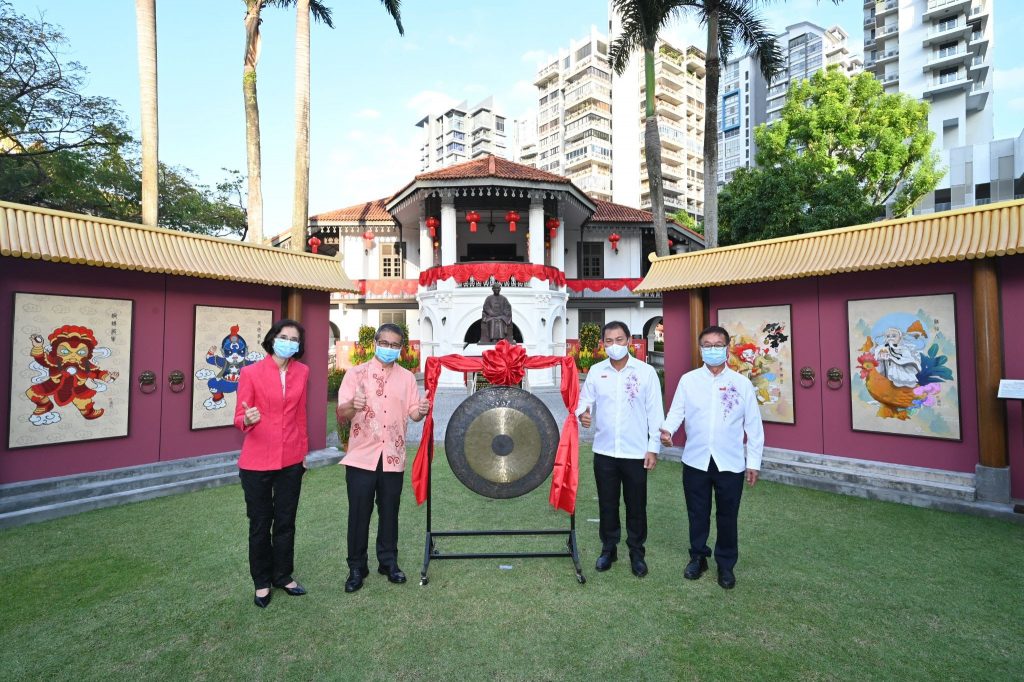
Together with esteemed guests, Chairman of SYSNMH Board, Mr Pek Lian Guan; Chief Executive Officer, National Heritage Board, Ms Chang Hwee Nee; and President, Singapore Chinese Chamber of Commerce & Industry, Mr Roland Ng, Minister Tong struck a gong on the front lawn of the Memorial Hall to mark the official launch of the special exhibition and proceeded to the gallery to view the artefacts on display.
Nian Hua: Of Deities, Guardians and Auspicious Art will run from 21 January to 25 September 2022, and is a highlight event for SYSNMH, as well as its key Lunar New Year offering. It is launched alongside Wan Qing Festival of Spring 2022, where visitors can expect a line-up of exciting activities to usher in the Year of the Tiger.
Nian Hua, which translates to “new year prints”, are colourful woodblock-printed images that adorned homes in Chinese villages and cities during the Lunar New Year. They were used by families to seek protection and blessings for their households for the year ahead.
Through the exhibition, the Memorial Hall seeks to shed light on Chinese traditions, popular beliefs and folk customs, and how these have evolved, particularly in Singapore, over the years. It also spotlights our intangible cultural heritage, which includes woodblock printing as a traditional craft, and the celebration of Lunar New Year.
The collection on display covers artefacts produced during the Qing dynasty (1636-1912) to the 1980s. It also includes curated prints from the collections of the National Museum of Singapore, Asian Civilisations Museum and Singapore Art Museum, and modern-day interpretations of Nian Hua by local and international artists. Woodblock moulds sourced from a private lender in Singapore will also be showcased for the first time.
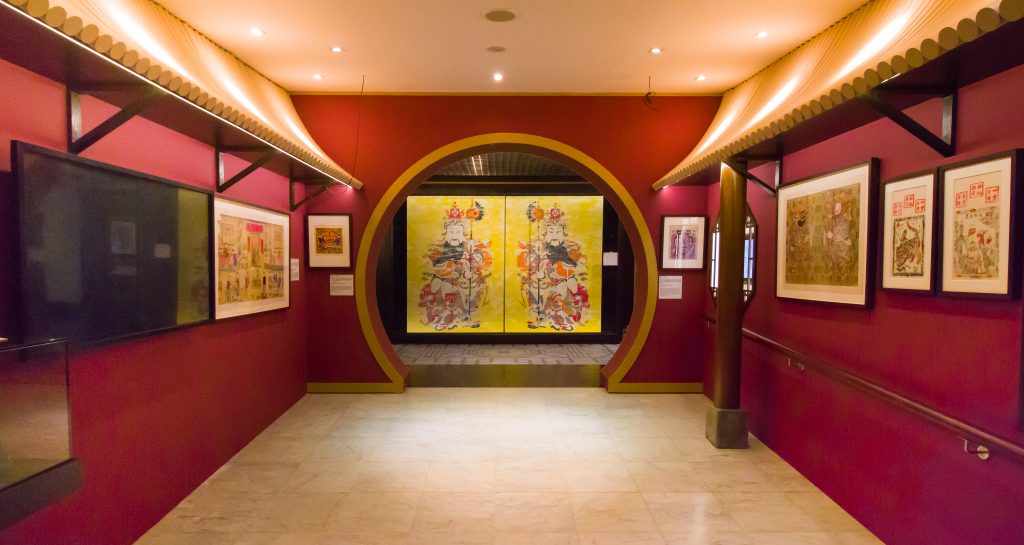
Mr Loo Say Chong, the private collector and researcher who loaned the woodblock moulds, said: “Woodblock printing has an important place in Chinese history and culture. It is a craft that requires precision, both during carving and during alignment for printing. It also helped to facilitate the transmission of knowledge and information. I am glad that my collection of woodblock moulds can help to raise awareness about this intangible cultural heritage as part of the Nian Hua exhibition.”
Ms Jermaine Chua, curator at SYSNMH, said: “While new year prints are no longer commonly found in Singapore and Southeast Asia, it remains an important art form in Chinese culture, as the characters, motifs and stories depicted reflect the values, beliefs and traditions practised by generations of families, and their hopes and wishes for the future, which have been rarely documented. By taking a closer look at Nian Hua, we also gain a better understanding and appreciation of our intangible cultural heritage.”
The exhibition at SYSNMH will be open from 10am to 5pm from Tuesdays to Sundays.
For more information on Nian Hua: Of Deities, Guardians and Auspicious Art, please visit: www.sysnmh.org.sg.
About the exhibition
The exhibition will be presented across four main sections – Door Deities and Guardians; Kitchen God, Earth God and other Deities; Blessings for the Bedchambers; and Happiness, Prosperity and Longevity.
Protecting households from evil spirits
Door deities and guardians are painted or pasted on the doors of households to protect families by barring evil spirits from entering. Nian Hua depicting door gods usually come in a pair, one for each side of the door, and are the earliest form of new year prints. The sale of such prints for the Lunar New Year was believed to have started during the Song dynasty (960-1297), especially the 12th and 13th centuries.
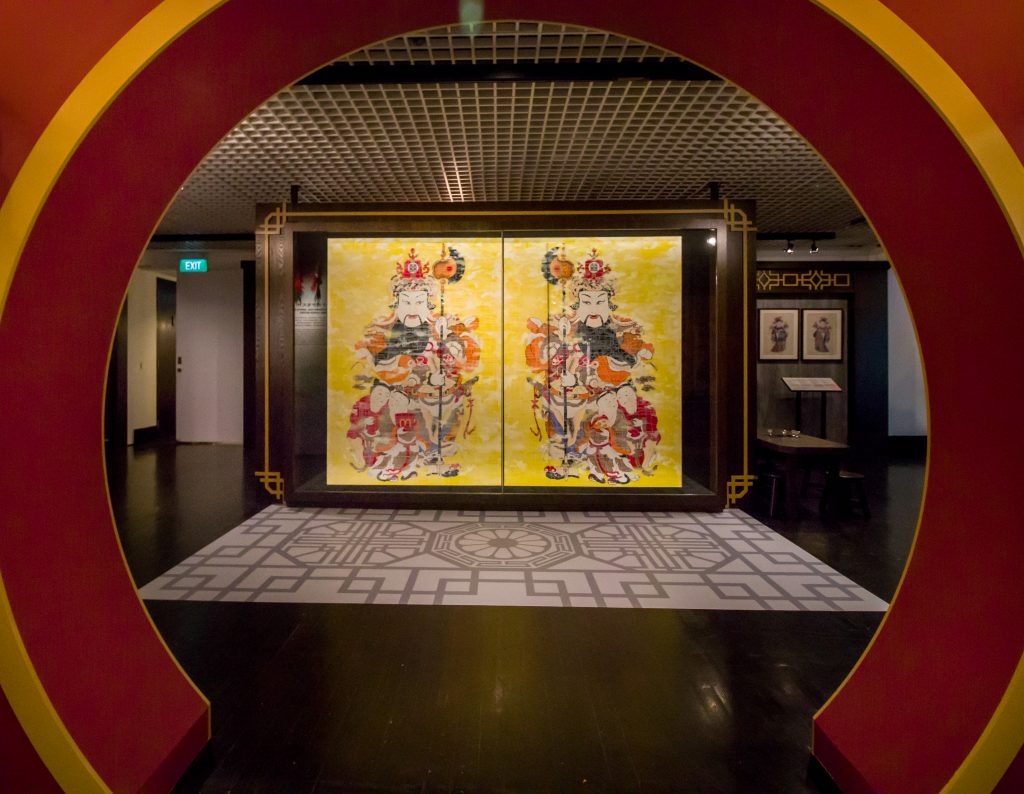
These door deities and guardians were often originally demon slayers such as Shenshu and Yulu, and Zhong Kui. From the 16th century, the Chinese also began to depict figures such as celestial officials, who are believed to bestow blessings of wealth and longevity upon the family. Subsequently, door prints came to include a repertoire of auspicious decorations ranging from immortals from folk religions to deified persons to Chinese opera characters.
Military door deities Qin Qiong and Yuchi Gong against a “double happiness” background (early – mid 20th century)
Yangliuqing, Tianjin
This print depicts the two favoured generals of the Tang dynasty Taizong Emperor, Qin Qiong (left) and Yuchi Gong (right). According to Chinese folklore, the emperor was plagued by nightmares of evil spirits screaming outside the palace. The emperor assigned two of his best generals to stand guard outside the palace gates while he slept and the nightmares stopped. As it was difficult for the generals to stand guard every night, the emperor ordered their likenesses to be painted on the palace gates. From then on, likenesses of the two generals have been used on new year prints as a form of protection for the household.
Collection of National Museum of Singapore
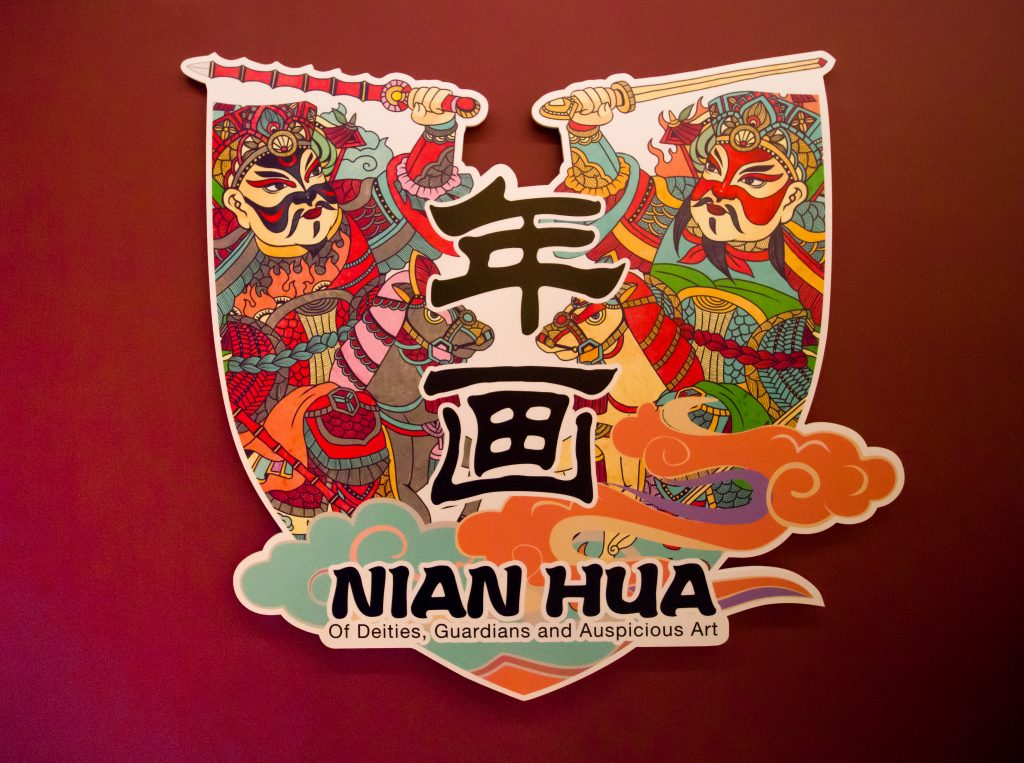
Prayers to the Kitchen God, Earth God and other deities for blessings and protection
The Chinese were traditionally polytheists who believed in many deities, including figures from Chinese mythology, Taoism and Buddhism. They believed that there were numerous deities, immortals and deified heroes who ruled over the three realms of heaven, earth and hell. Consequently, images of these deities were printed on paper for the common people to pray to in their homes for both blessings and protection.
Kitchen God and wife (1942)
Yangliuqing, Tianjin
This print features the Kitchen God and his wife in front of an offering table with an incense burner, candles and flowers. A ju bao pen, (“treasure basin”), is also placed on the ground before them. The ju bao pen is usually filled with money and precious materials such as coral and pearls and is believed to bring wealth to the household. In front of them are two attendants carrying the characters for longevity (shou) and blessings (fu). A lunisolar calendar, which is based on the phases of the moon and indicates months of the solar year, can be found on the upper portion of the print.
Collection of National Museum of Singapore
Tua Pek Kong (“Granduncle”) (date unknown)
Singapore
Da bo gong, commonly known in Hokkien as Tua Pek Kong, is a deity unique to Southeast Asia and is worshipped by the Chinese communities of Singapore, Malaysia and Indonesia as the God of Prosperity and Wealth. The earliest mention of the deity was found on a stele dating back to 1793 in Pek Kong Beo (bo gong miao, “Bogong temple”) in Pahang.
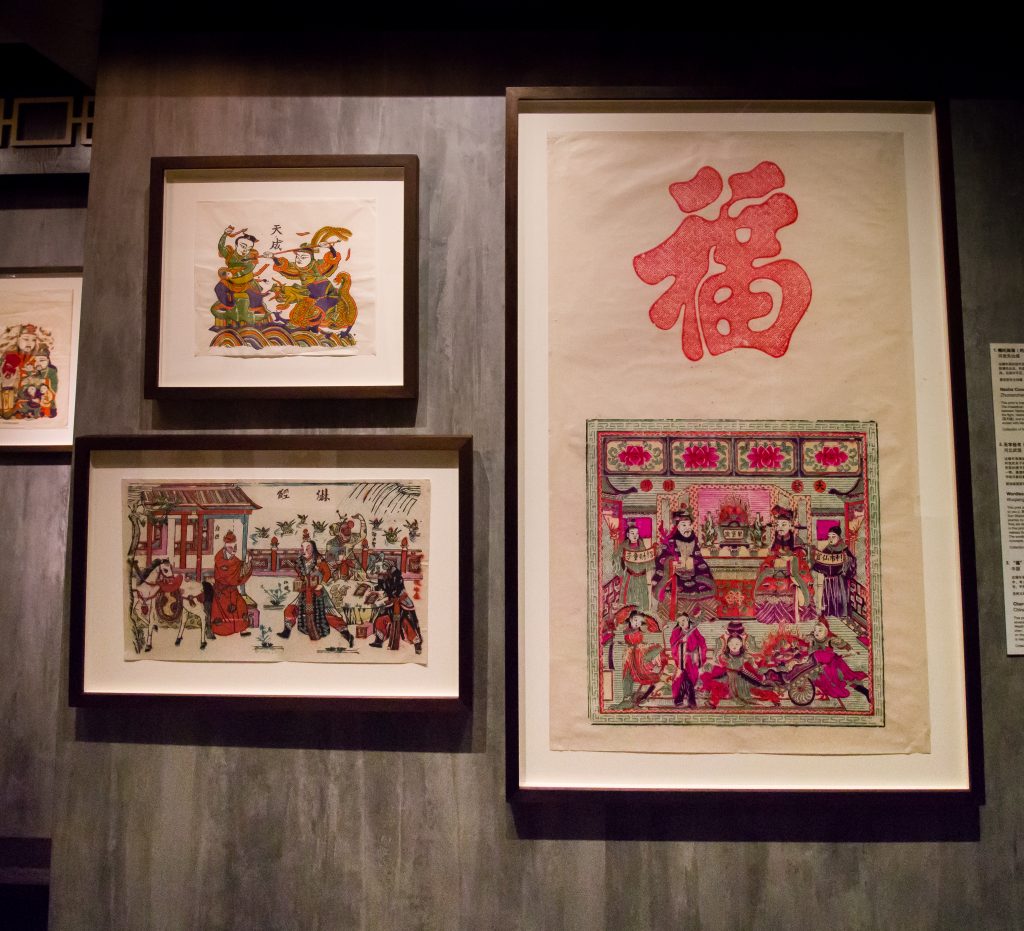
However, the origins and identity of Da bo gong are still disputed. The Chinese in Penang believe that he was Zhang Li, a Hakka political refugee and the first known Chinese settler in Penang. He was also the founder of Tua Pek Kong Society, a mutual aid organisation based on sworn brotherhood. Hence, Da bo gong became a symbol of sworn brotherhood among the overseas Chinese community. Many also believe that Tua Pek Kong embodies the spirits of overseas Chinese pioneers who helped and protected the Chinese community.
Collection of National Museum of Singapore
Nian Hua for blessings for the bedchambers
In the past, children, especially boys, held a very special place in Chinese society for the role they play in the perpetuation of the family line. As such, married Chinese couples are traditionally expected to bear sons soon after marriage as having no heirs was considered the most serious of unfilial deeds (bu xiao you san wu hou wei da). The importance of having male heirs was of such significance to the Chinese that it was common for new year prints to depict symbols and auspicious sayings of fertility. These prints were often pasted inside or on the bedroom doors of married couples.
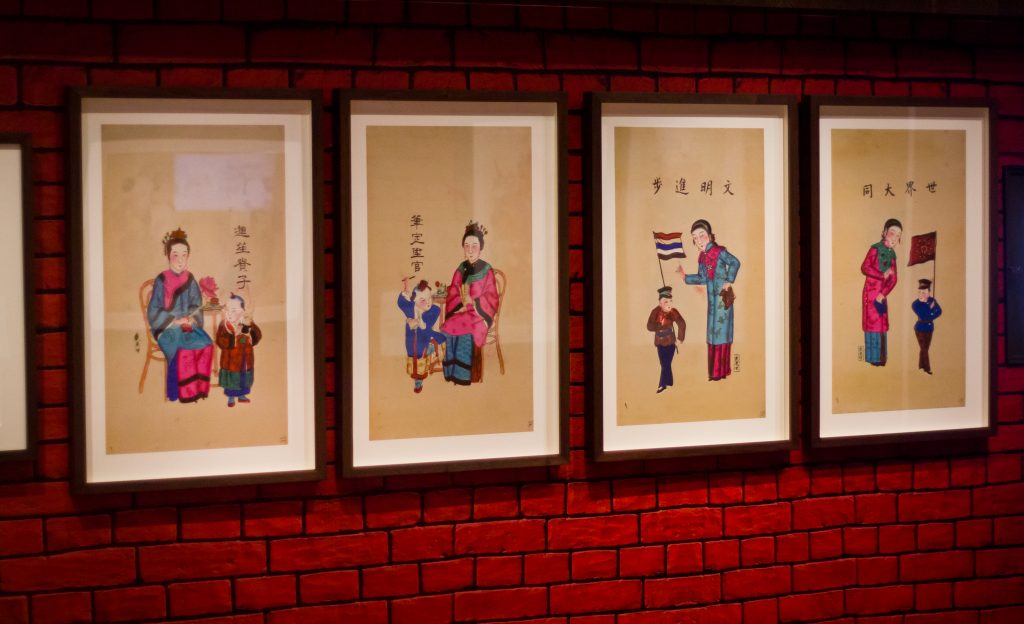
Door deities with five children (mid 1940s – mid 1960s)
Taohuawu, Suzhou
This pair of prints depicts the door deities Qin Qiong and Yuchi Gong with five children each. The five children represent the five sons of Dou Yujun, who lived during the Five Dynasties period (907 – 979). All of Dou’s sons were extremely gifted and all of them passed the civil service examinations. As such, the Chinese idiom “wu zi deng ke” is used to express one’s wish for their children to enjoy success in life.
One of the children in the print is shown in the print as riding a qi lin. The qi lin is a symbol of fertility and, in this print, it is depicted with a child wearing official robes on its back, hence alluding to the blessing of a son who will bring glory to the family in the future.
Collection of National Museum of Singapore
Progressive civilisation, harmonious society
(early Republican period)
Yangliuqing, Tianjin
The 1911 Revolution, sparked off by the Wuchang Uprising, ended dynastic rule in China and established a modern republic. In keeping with the spirit of the times, print shops in China produced new year prints to celebrate and commemorate this momentous event in Chinese history. These two prints feature young mothers with their sons in modern, military-style uniforms with one holding the 18-Star Flag (the banner of the Wuchang Uprising) and the other holding the Five-Coloured Flag (the first national flag of the Republic of China).
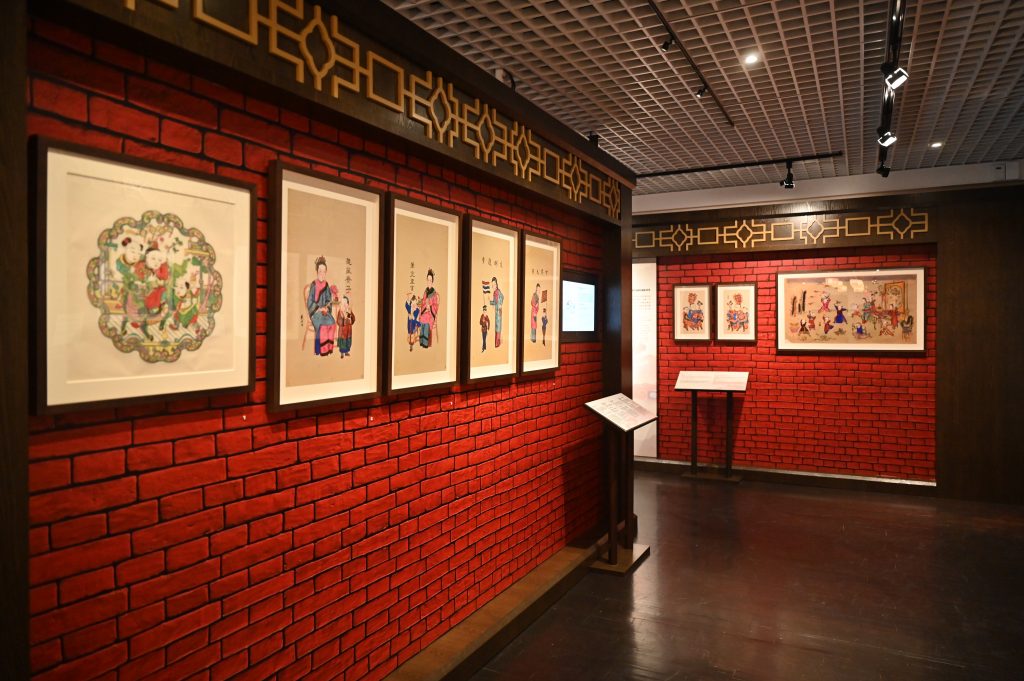
The slogans “towards a progressive civilisation” (wen ming jin bu) and “a harmonious and equal society” (shi jie da tong) are representative of Dr. Sun Yat Sen’s political vision for the new republic.
Reproduced with permission of Chongqing China Three Gorges Museum
Wishes for a happy, prosperous and long life
By surrounding themselves with auspicious prints and decorations, the Chinese believe that these items will make their wishes come true and bring them good fortune. Hence, the prints that the common people hang in their homes and paste on their doors provide useful insights into what was important to them. While the symbols used in these prints vary, the common wishes of the people include the desire for a long life, prosperity, and a happy family preferably with successful sons.
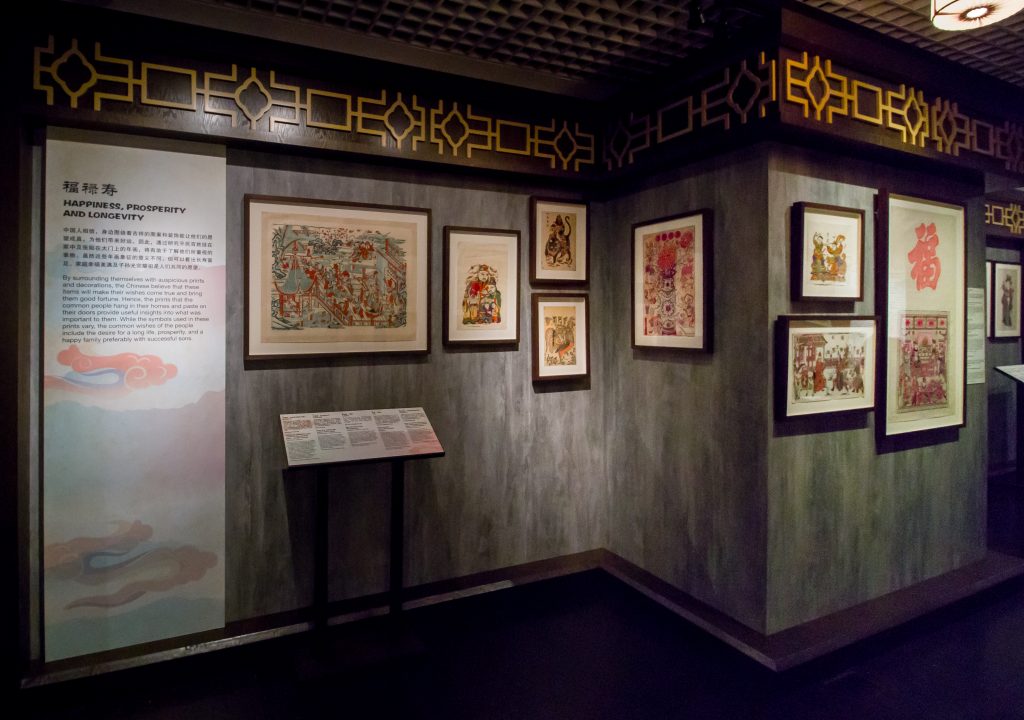
Man on large rooster (Qing dynasty)
Jiangzhou, Shanxi province
This print features a man astride a large rooster, holding the wish-granting ru yi (“as you wish”) sceptre and an osmanthus branch, which symbolise the fulfilment of all of one’s wishes and career advancement. On four corners of the print are auspicious symbols related to good fortune or success in the imperial examinations. For example, the three citrons (san yuan) at the bottom left are a reference to the phrase “may you achieve the three successive firsts” (lian zhong san yuan) in the provincial, metropolitan and imperial examinations.
The rooster is believed to be able to chase away darkness and evil spirits as it crows in the morning together with the rising sun. A large rooster (da ji) is also homophonous with the term for good fortune (da ji). The rooster’s comb (ji guan) is likewise a wordplay on “official” (guan), hence reinforcing the wish to have good fortune and a successful career in the year ahead.
Reproduced with permission of Chongqing China Three Gorges Museum
Liu Hai teasing the golden toad (circa 1980s)
Zhuxianzhen, Henan province
This print features another popular Chinese God of Wealth, Liu Hai, who is depicted with his three-legged mythical toad (san zu chan chu).
The three-legged toad is a popular mythical creature associated with wealth and good fortune, and is depicted with two strings of coins in its mouth. Apart from having only three legs, the toad is also depicted with the Yin-Yang symbol on its head, and seven diamond spots on its back representing the Big Dipper constellation (bei dou qi xing).
Collection of Mr. Jimm Wong Pui Fatt









